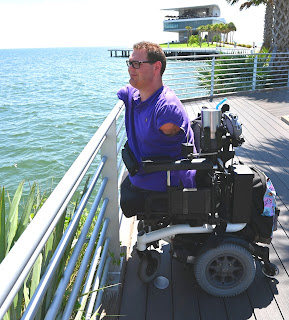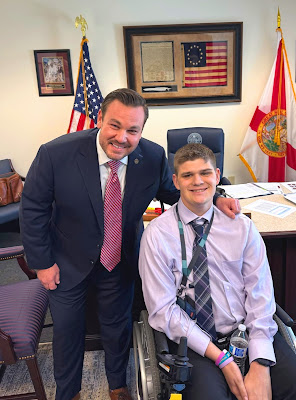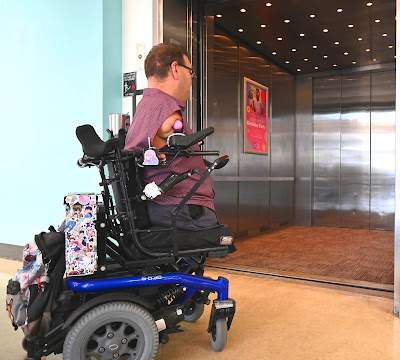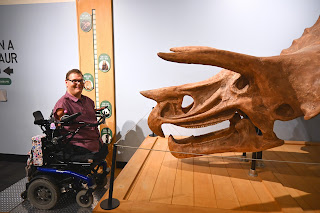Accessibility Grade: A-
Museums are wonderful places for people to learn, create, and have a ton of fun along the way! At the Glazer Children's Museum, there are a wide variety of exhibits and activities for the entire family. From dinosaur fossils (including Big John, one of the largest, most complete triceratops fossils in the world), to arts and crafts, to a fire truck simulator, this museum is a great place for children and adults to learn about our local community and the rest of our planet. But what is the museum's accessibility like? Come with me on a virtual tour, as we explore the accessible features of the Glazer Children's Museum.
Accessible Parking
While we didn't get any pictures of the parking situation, we definitely had a difficult time finding accessible parking; however, I must point out that this isn't the museum's fault. All in all, finding parking in Downtown Tampa, especially accessible parking, can be pretty difficult. To begin with, it was unclear where we should park. After finally navigating the busy streets, which were under construction, we finally found our way to the recommended William F. Poe garage. To enter, you must be able to grab a token from the machine, located at the garage's entrance. It's a good thing that I wasn't alone, because I am a quad-amputee, which means that I couldn't reach out of my window to use the machine. I needed assistance to do this. Once we were finally inside, the garage was also under construction, which made it more confusing to navigate. Once we parked, we even had difficulty figuring out how to exit the garage, and make our way to the museum. The accessible entrance is located on the west side of the building, between the Glazer Children's Museum and the Tampa Museum of Art, which was also difficult for us to find. Are you noticing a pattern, here? It was a shame to experience these struggles, even before we got the chance to enter the museum. It's especially frustrating because the museum ended up being such a remarkable institution. But now that we have that out of the way, let's get to talking about the museum, itself!
Accessibility Accommodations & Devices The Glazer Children's museum does a great job of accommodating a variety of accessibility needs. If you have mobility limitations and need something like a wheelchair, they have a limited number of VELA mobility chairs. These are free for guests to rent and are available, by request, at Guest Services. Keep in mind that they are first come, first served. If you need a VELA mobility chair, before you arrive at the children's museum, it would be a good idea to call and request one. In addition to these mobility devices, the museum offers a number of additional accessibility devices. This service includes important resources for children with disabilities, including weighted vests, fidget toys, noise-cancelling headphones, sound amplifiers, and more.
For individuals who are hard of hearing, or who have an auditory processing disorder, you can rent a device called a Poketalker Sound Amplifier. It can help to increase the level of sound that is closest to you, while cutting out background noise. It can either be used with or without hearing aids. For kiddos who experience red-green color blindness, a pair of child-size EnChtroma Glasses are available to rent. Lastly, for kids and adults who experience sensory sensitivities, KultureCity Sensory Bags are available at guest services, upon request. Within them, guests will find a few helpful tools, including: noise reducing headphones from Pure Sound Labs, fidget devices of different types (marble, noodle, and mesh), strobe reduction glasses, a VIP lanyard, a visual cue card, and a weighted lap pad.
Along with the accommodations listed above, the Glazer Children's museum has a variety of accessible facilities. These include an oversized elevator, which is plenty big, and can fit at least two to three large, power wheelchairs. Additionally, accessible restrooms are also located near the elevators, on every floor. They include accessible stalls, as well as changing tables. Note: all toilets have an automatic flushing feature. If you or your child experience sensory sensitivity and feel like this feature is too noisy, Guest Service will be happy to give you a Sensor Cover to help reduce any loud noise coming from the toilets.
Onto The Exhibits!
KidsPort
The first exhibit that we visited was KidsPort. Here, kids can enjoy playing with a variety of water toys. A replica of the Skyway Bridge stands at the middle, surrounded by sea creatures, boats, helicopters, and more. You can send a ball all the way across the bridge, and see how long it takes to reach the other side. The height of the KidsPort should be appropriate for most kiddos; however, if your child is a wheelchair user, there's a chance that they could experience difficulty reaching into the exhibit and playing with the water toys. Of course, this experience will be different for every child, so just keep that in mind.
After we rode the elevator upstairs, we made our way to the next exhibit: Art Smart. Here, kids have access to a large, open area. In this space, there are a variety of activities for them to engage with, including a variety of arts and crafts. Kiddos can build towers out of blocks and tiles. If your child loves music, there is an interactive wall mural a that's wonderful way to get your blood flowing. You may even want to use this opportunity to have that dance off you've been thinking about. Because there's so much room, this exhibit is plenty big for children who use mobility devices, such as wheelchairs, walkers, etc. From what we observed, everything appeared as if it would be within reach of children who use mobility equipment.
In this exhibit, kids can pretend that they are firefighters. Whether they want to slide down a pole, or take the firetruck simulator for a spin, this exhibit would be a blast for children who love to play firefighters. While we thought that these features were really cool, I should point that it may be tough for kids who have mobility disabilities. To get into the front seat of the fire truck, you may need to transfer your child from their wheelchair. Depending on their core strength, they also may need assistance to stand up straight, or reach any of the devices, such as the steering wheel. Though the Firehouse exhibit was really cool, due its nature, I was under the impression that it wouldn't be very accessible for some children who have mobility disabilities.
Here, a number of art supplies are available to children and their families, where everybody is encouraged to be flex their art muscles to create their own works of art! While we visited, families were using art supplies to make their own gingerbread houses. Depending on when you go to the Glazer Children's Museum, this space may be used to create different kinds of artwork, with different kinds of supplies. This space was really accessible. The Make Space features a couple of long, wooden tables, where you and your family can channel your inner artist. The size of the tables offer plenty of room for people who use mobility devices. The stools are also easy to move out of the way, making it even easier to access the tables.
Ocean SandboxThis exhibit appeared to be great for kiddos who are on the autism spectrum. It had low light and, since it was situated away from other exhibits, there was significantly less noise. While the kids play around with the sand, an overhead projector shines an ocean scene onto it. They can play around with the sand, or even use it as a good chance to stim, while watching a variety of sea creatures glide across its smooth surface.
Big John
Since I was a kid, I've been absolutely obsessed with dinosaurs. It just so happens that the Glazer Children's Museum is home to the largest, and one of the most complete, Triceratops fossils in the world! Standing at about 10 feet tall, and 26 feet long, Big John obviously gets his namesake from his massive size! In fact, he's estimated to be about 5-10% larger than any triceratops that we've discovered, up to this point in time. Likely from a fight with another Triceratops, Big John had sustained an injury to his frill, which is evident by the large hole in it. There's even a tunnel, leading under Big John, allowing kids the opportunity to see the fossil from a different view; however, this tunnel was too low to the ground for most, if not all, wheelchair users. Just something to keep in mind.
Within the exhibit, there are a bunch of other fun, dinosaur-related, interactive displays to explore! Located on one of the walls, the picture on the right shows one of the museum staff, flipping up a panel. Behind these are a number of facts about paleontology, dinosaurs, as well as Big John. If your kiddo is a wheelchair user, they may experience some difficulty reaching some of the panels, located towards the top of this, specific exhibit.
Mounted on another wall, you'll find a puzzle of a triceratops fossil. It's low to the ground, making it a great height for younger kids, as well as kiddos who are wheelchair users. This is a wonderful detail, because it encourages children to play together, whether they use mobility equipment or not. By putting the puzzle together, they can learn a bit more about Big John's skeleton, where they can see and feel how each bone fits together. It also encourages them to engage with spatial awareness.
If you and your kid also love art, the Scanning Station will allow you to create your very own dinosaur! By coloring a dinosaur sheet, and then scanning it, your colorful creation will come to life. A projector, mounted on the ceiling, shows an image of a prehistoric landscape. After placing your colored dinosaur in the tray, shown in the image to the right, your dinosaur will walk around with other dinosaurs that have been colored and scanned by other visitors. You can also scan the QR code, located on the sign above the scanning station, to design your dinosaur on a smart device, such as a phone or tablet. I thought that this was a wonderful, accessibility feature! Unfortunately, because of the lighting we couldn't get a good picture of the dinosaurs in action. That just means you'll have to visit to see it for yourself! In addition to the wonderful exhibits that the Glazer Children's Museum has to offer, their inclusive programs make the institution a great resource for families with disabled children. Each summer, the museum hosts Camp Imagination. During select weeks, they feature additional staff, who are specially trained and knowledgeable of children with disabilities. They also have a quiet room for campers who experience sensory sensitivities, such as children on the autism spectrum. You can even request reimbursement through the museum's program, called the "Family Empowerment Scholarship for Students with Unique Abilities." If you are interested, send an email to camps@glazermuseum.org and request an application.
In closing, the Glazer Children's Museum was a wonderful institution. As mentioned above, just be mindful of the parking situation. Aside from that, the museum itself offers a safe space to learn, for children and parents alike.
Author:
Kyle Romano
Photographer:
Luis Rodriguez
 Once again, the holiday season is here! If your family is anything like mine, that means spending a lot of time with parents, siblings, aunts, uncles, cousins, and even friends. If you've ever wondered whether your place is accessible, fear not! Here are some tips to help you plan a holiday party that will be inviting to all of your guests, whether they use mobility equipment or not.
Once again, the holiday season is here! If your family is anything like mine, that means spending a lot of time with parents, siblings, aunts, uncles, cousins, and even friends. If you've ever wondered whether your place is accessible, fear not! Here are some tips to help you plan a holiday party that will be inviting to all of your guests, whether they use mobility equipment or not. Tires, and even some low-hanging parts, can actually get stuck in the cracks between each stone. The front casters of manual wheelchairs tend to catch on these gaps, making them both difficult and dangerous to traverse. Depending on how they're laid, pavers and cobblestones can also make for a pretty bumpy ride, making things more difficult for people who need extra support for their necks and backs.
Tires, and even some low-hanging parts, can actually get stuck in the cracks between each stone. The front casters of manual wheelchairs tend to catch on these gaps, making them both difficult and dangerous to traverse. Depending on how they're laid, pavers and cobblestones can also make for a pretty bumpy ride, making things more difficult for people who need extra support for their necks and backs. Lawn parties can be a great way to spend time with your friends and family, but what if you're trying to put together a lawn party that's accessible to people who use mobility devices? While lush, green grass looks beautiful, it may be tough for manual wheelchair users to push themselves through. Unseen dips and holes could also make things tricky for people who are visually impaired or use power wheelchairs, walkers, canes, etc. In my heyday, I was known to flip a chair or two, so I've been on the receiving end of surprise lawn holes. Thick grass can also be tough on the motors of power wheelchairs, causing more wear and tear than usual. If you're worried that your yard may be too lush for it's own good, you can lay down some boards that lead from your house to the area where you'll be hanging out. If you're still concerned, it may be better to host your party indoors, or at least on a patio.
Lawn parties can be a great way to spend time with your friends and family, but what if you're trying to put together a lawn party that's accessible to people who use mobility devices? While lush, green grass looks beautiful, it may be tough for manual wheelchair users to push themselves through. Unseen dips and holes could also make things tricky for people who are visually impaired or use power wheelchairs, walkers, canes, etc. In my heyday, I was known to flip a chair or two, so I've been on the receiving end of surprise lawn holes. Thick grass can also be tough on the motors of power wheelchairs, causing more wear and tear than usual. If you're worried that your yard may be too lush for it's own good, you can lay down some boards that lead from your house to the area where you'll be hanging out. If you're still concerned, it may be better to host your party indoors, or at least on a patio.


















































